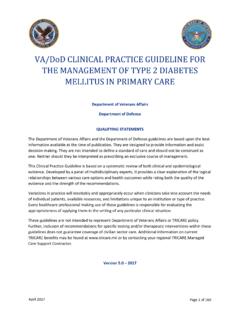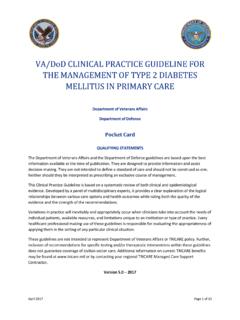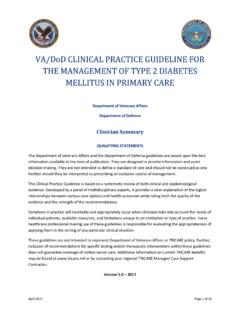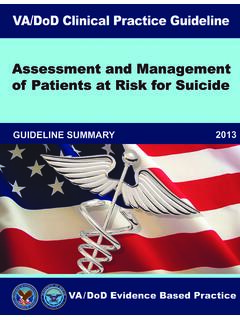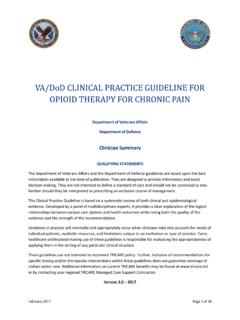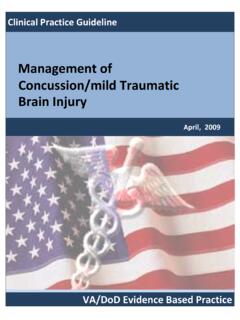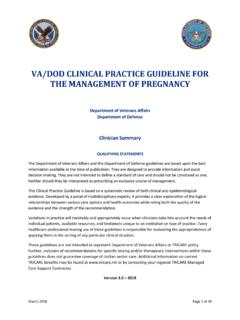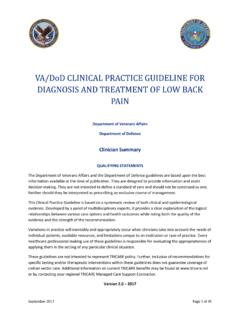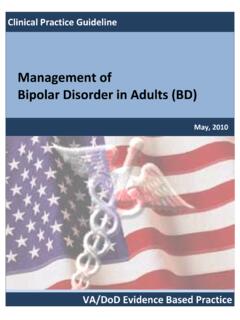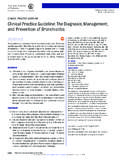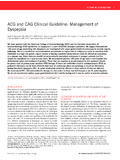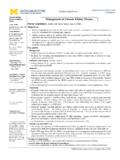Transcription of VA/DOD Clinical Practice Guideline for the Management of ...
1 VA/DOD Clinical Practice Guideline FOR THE Management OF posttraumatic stress DISORDER AND ACUTE stress DISORDER Department of Veterans Affairs Department of Defense QUALIFYING STATEMENTS The Department of Veterans Affairs and the Department of Defense guidelines are based upon the best information available at the time of publication. They are designed to provide information and assist decision making. They are not intended to define a standard of care and should not be construed as one. Neither should they be interpreted as prescribing an exclusive course of Management . This Clinical Practice Guideline is based on a systematic review of both Clinical and epidemiological evidence. Developed by a panel of multidisciplinary experts, it provides a clear explanation of the logical relationships between various care options and health outcomes while rating both the quality of the evidence and the strength of the recommendation.
2 Variations in Practice will inevitably and appropriately occur when clinicians take into account the needs of individual patients, available resources, and limitations unique to an institution or type of Practice . Every healthcare professional making use of these guidelines is responsible for evaluating the appropriateness of applying them in the setting of any particular Clinical situation. These guidelines are not intended to represent TRICARE policy. Further, inclusion of recommendations for specific testing and/or therapeutic interventions within these guidelines does not guarantee coverage of civilian sector care. Additional information on current TRICARE benefits may be found at or by contacting your regional TRICARE Managed Care Support Contractor.
3 Version 2017 VA/DOD Clinical Practice Guideline for the Management of posttraumatic stress Disorder and Acute stress Disorder June 2017 Page 2 of 200 Prepared by: The Management of posttraumatic stress Disorder Work Group With support from: The Office of Quality, Safety and Value, VA, Washington, DC & Office of Evidence Based Practice , Army Medical Command Version 2017 Based on evidence reviewed through March 2016 VA/DOD Clinical Practice Guideline for the Management of posttraumatic stress Disorder and Acute stress Disorder June 2017 Page 3 of 200 Table of Contents I. Introduction .. 5 II. Background .. 5 A. Definition of Traumatic Events .. 5 B. Acute stress Reaction and Diagnosis of Acute stress Disorder.
4 6 C. Diagnosis of posttraumatic stress Disorder .. 8 D. DSM-IV versus DSM-5: Clinical Practice Guideline Implications .. 11 E. Epidemiology and Impact .. 13 III. About this Clinical Practice Guideline .. 16 A. Methods .. 16 B. Summary of Patient Focus Group Methods and Findings .. 20 C. Conflicts of Interest .. 21 D. Scope of this Clinical Practice Guideline .. 21 E. Highlighted Features of this Clinical Practice Guideline .. 22 F. Patient-centered Care .. 22 G. Shared Decision Making .. 23 H. Background on Co-occurring Conditions with posttraumatic stress Disorder .. 23 I. Implementation .. 24 IV. Guideline Work Group .. 26 V. Algorithm .. 27 Module A: Acute stress Reaction/Disorder .. 28 Module B: Assessment and Diagnosis of posttraumatic stress Disorder.
5 30 Module C: Management of posttraumatic stress Disorder .. 32 VI. Recommendations .. 33 A. General Clinical Management .. 37 B. Diagnosis and Assessment of posttraumatic stress Disorder .. 39 C. Prevention of posttraumatic stress Disorder .. 41 D. Treatment of posttraumatic stress Disorder .. 44 E. Treatment of posttraumatic stress Disorder with Co-occurring Conditions .. 72 VII. Knowledge Gaps and Recommended Research .. 76 A. Shared Decision Making and Collaborative Care .. 76 B. Treatments for Acute stress Disorder and Preventing posttraumatic stress Disorder .. 76 VA/DOD Clinical Practice Guideline for the Management of posttraumatic stress Disorder and Acute stress Disorder June 2017 Page 4 of 200 C. Treatments for posttraumatic stress Disorder.
6 76 D. Non-Pharmacologic Biological Treatments for posttraumatic stress Disorder .. 78 E. Technology-based Treatments for posttraumatic stress Disorder .. 78 F. Treatments for posttraumatic stress Disorder with Comorbidities and Co-occurring Appendix A: Evidence Review Methodology .. 79 A. Developing the Scope and Key Questions .. 79 B. Conducting the Systematic Review .. 83 C. Convening the Face-to-face Meeting .. 87 D. Grading Recommendations .. 88 E. Recommendation Categorization .. 91 F. Drafting and Submitting the Final Clinical Practice Guideline .. 93 Appendix B: Patient Focus Group Methods and Findings .. 95 A. Methods .. 95 B. Patient Focus Group Findings .. 95 Appendix C: Pharmacotherapy Dosing 97 Appendix D: Evidence Table .. 98 Appendix E: 2010 Recommendation Categorization Table.
7 104 Appendix F: Participant List .. 140 Appendix G: Literature Review Search Terms and Strategy .. 142 A. Topic-specific Search Terms .. 142 B. Search Strategies .. 156 Appendix H: Abbreviation List .. 183 References .. 186 VA/DOD Clinical Practice Guideline for the Management of posttraumatic stress Disorder and Acute stress Disorder June 2017 Page 5 of 200 I. Introduction The Department of Veterans Affairs (VA) and the Department of Defense (DoD) Evidence-Based Practice Work Group (EBPWG) was established and first chartered in 2004, with a mission to advise the ..Health Executive Council on the use of Clinical and epidemiological evidence to improve the health of the population across the Veterans Health Administration and Military Health System, by facilitating the development of Clinical Practice guidelines (CPGs) for the VA and DoD populations.
8 [1] This CPG is intended to provide healthcare providers with a framework by which to evaluate, treat, and manage the individual needs and preferences of patients with posttraumatic stress disorder (PTSD) and acute stress disorder (ASD), thereby leading to improved Clinical outcomes. In 2010, the VA and DoD published a CPG for the Management of Post-Traumatic stress and Acute stress Reaction (2010 PTSD CPG), which was based on evidence reviewed through March 2009. Since the release of that Guideline , a growing body of research has expanded the general knowledge and understanding of PTSD and other stress related disorders , such as ASD and other acute reactions to trauma (sometimes referred to as acute stress reactions [ASR]). Improved recognition of the complex nature of ASR, ASD, and PTSD has led to the adoption of new or refined strategies to manage and treat patients with these conditions.
9 Consequently, a recommendation to update the 2010 PTSD CPG was initiated in 2015. The updated CPG includes objective, evidence-based information on the Management of PTSD and related conditions. It is intended to assist healthcare providers in all aspects of patient care, including, but not limited to, diagnosis, treatment, and follow-up. The system-wide goal of developing evidence-based guidelines is to improve the patient s health and well-being by guiding health providers who are taking care of patients with PTSD along the Management pathways that are supported by evidence. The expected outcome of successful implementation of this Guideline is to: Enhance assessment of the patient s condition and determine the best treatment method in collaboration with the patient and, when possible and desired, the patient s family and caregivers Optimize the patient s health outcomes and improve quality of life Minimize preventable complications and morbidity Emphasize the use of patient-centered care II.
10 Background A. Definition of Traumatic Events A traumatic event is defined in the Diagnostic and Statistical Manual of Mental disorders , Fifth Edition (DSM-5) as an event (or series of events) in which an individual has been personally or indirectly exposed to actual or threatened death, serious injury, or sexual violence. There is a wide spectrum of psychological responses to traumatic events, ranging from normal, transient, non-debilitating symptoms to a transient ASR to an acute, time-limited and clinically-significant Clinical disorder (ASD) to a persistent disorder (PTSD) that may become chronic, if untreated. VA/DOD Clinical Practice Guideline for the Management of posttraumatic stress Disorder and Acute stress Disorder June 2017 Page 6 of 200 The DSM-5 definition of traumatic events is the same for both ASD and PTSD, and one can meet the trauma definition with any one of four criteria (A1-A4) (see Table 1 and Table 2).
